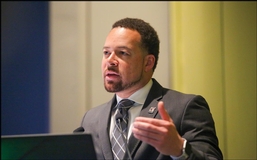
Rochon
Pipeline programs that promote diversity are key to boosting the number of underrepresented minorities in radiology, according to an expert who spoke Wednesday.
Radiology has experienced a paucity of underrepresented minorities for years. Recent reports show single-digit percentages of underrepresented minorities across all radiology career levels and subspecialties. In 2012, underrepresented minorities made up only about 8% of diagnostic radiology residents, ranking radiology 18th in diversity among physician specialties, said session presenter Paul Rochon, MD, associate professor at the University of Colorado School of Medicine in Boulder.
Dr. Rochon is a member of the Society of Interventional Radiology (SIR), where he is among the 1% of members who reported being a member of a minority.
"There is a lot we need to do and that's where pipeline programs come into play," Dr. Rochon said.
Pipeline programs provide educational and career support to students from underrepresented minorities interested in applying to or entering the health care field. As an example, Dr. Rochon cited the pipeline program Nth Dimensions, a 2004 initiative targeting underrepresented minorities in orthopedic surgery. The program implemented a targeted pipeline curriculum that included a summer internship.
A 2016 study found that completion of the internship was associated with increased odds of applying to an orthopedic surgery residency.
"We need to embrace and enact these kinds of diversity and inclusion efforts at our local institutions where we can share the passion that we have in our profession," Dr. Rochon said.
Outreach efforts should target both medical students and undergraduates. Radiology department representatives can help by making medical school students feel welcome throughout the interview process. At the undergraduate level, Dr. Rochon recommended stronger recruitment efforts at schools with a high percentage of underrepresented minorities, like traditional black colleges and Puerto Rican schools.
"When I was in a pre-professional program at my undergraduate institution, all we really knew were the primary care specialties because they were the physicians who were able to go out to our school," he said. "So I challenge those of us who work in radiology to make an effort to go back to your undergraduate institutions."
Progress Starts at the Ground Level
Mentorship and sponsorship go hand-in-hand by helping guide underrepresented students and positioning them to succeed.
"It's important we're doing things from a national, organizational standpoint, but it really starts at the ground level," Dr. Rochon said.
The combined effort of RSNA, SIR and the American College of Radiology is also critical to improving minority representation in radiology. Dr. Rochon pointed to campaigns like Radiology Cares®, the Face of Radiology and SIR's Vision to Heal® as successful outreach initiatives.
Increasing minority faculty representation is another foundational component of promoting diversity, Dr. Rochon said. While minority professorship numbers have grown in recent years, lower rates of academic promotion bedevil radiology. Research shows that only 18% of black assistant professors advanced to associate professors compared to 30% of their white colleagues.
Minority recruitment would also benefit from efforts to dispel stereotypes about the radiologist being isolated from patient interaction, Dr. Rochon said.
"We know that it is not true, but that is what our medical students and people in other specialties believe," he said. "In fact there are a lot of opportunities for us to have direct patient care. We need to get out there in the community and let people know what we do."
Related links:
Twitter Poll
Has a mentor influenced your views on diversity in the radiology workplace? #RSNA19
— RSNA (@RSNA) December 4, 2019

